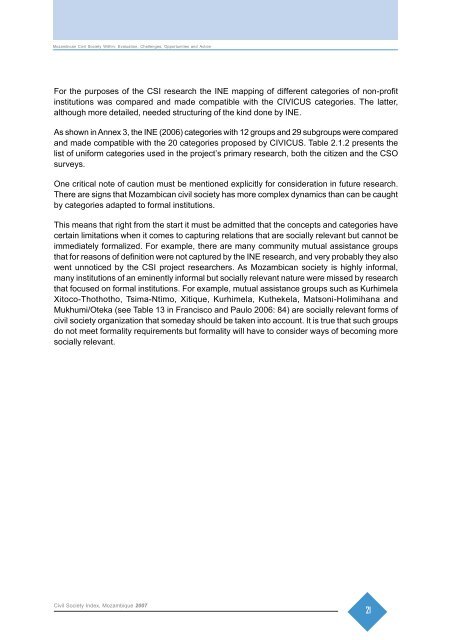Mozambican Civil Society Within: - UNICEF Mozambique - Home page
Mozambican Civil Society Within: - UNICEF Mozambique - Home page
Mozambican Civil Society Within: - UNICEF Mozambique - Home page
Create successful ePaper yourself
Turn your PDF publications into a flip-book with our unique Google optimized e-Paper software.
<strong>Mozambican</strong> <strong>Civil</strong> <strong>Society</strong> <strong>Within</strong>: Evaluation, Challenges, Opportunities and Action<br />
For the purposes of the CSI research the INE mapping of different categories of non-profit<br />
institutions was compared and made compatible with the CIVICUS categories. The latter,<br />
although more detailed, needed structuring of the kind done by INE.<br />
As shown in Annex 3, the INE (2006) categories with 12 groups and 29 subgroups were compared<br />
and made compatible with the 20 categories proposed by CIVICUS. Table 2.1.2 presents the<br />
list of uniform categories used in the project’s primary research, both the citizen and the CSO<br />
surveys.<br />
One critical note of caution must be mentioned explicitly for consideration in future research.<br />
There are signs that <strong>Mozambican</strong> civil society has more complex dynamics than can be caught<br />
by categories adapted to formal institutions.<br />
This means that right from the start it must be admitted that the concepts and categories have<br />
certain limitations when it comes to capturing relations that are socially relevant but cannot be<br />
immediately formalized. For example, there are many community mutual assistance groups<br />
that for reasons of definition were not captured by the INE research, and very probably they also<br />
went unnoticed by the CSI project researchers. As <strong>Mozambican</strong> society is highly informal,<br />
many institutions of an eminently informal but socially relevant nature were missed by research<br />
that focused on formal institutions. For example, mutual assistance groups such as Kurhimela<br />
Xitoco-Thothotho, Tsima-Ntimo, Xitique, Kurhimela, Kuthekela, Matsoni-Holimihana and<br />
Mukhumi/Oteka (see Table 13 in Francisco and Paulo 2006: 84) are socially relevant forms of<br />
civil society organization that someday should be taken into account. It is true that such groups<br />
do not meet formality requirements but formality will have to consider ways of becoming more<br />
socially relevant.<br />
<strong>Civil</strong> <strong>Society</strong> Index, <strong>Mozambique</strong> 2007<br />
21
















